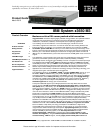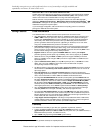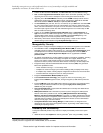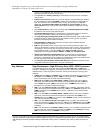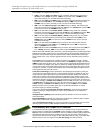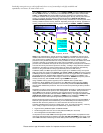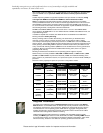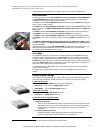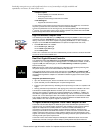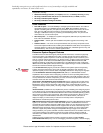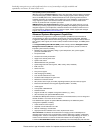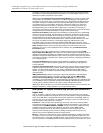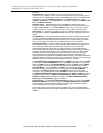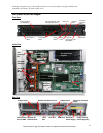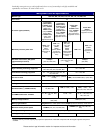
Leadership enterprise server with significantly lower cost of ownership in a highly available and
expandable, rack-dense, 2U dual-socket server
Please see the Legal Information section for important notices and information.
7
with six 2GB single-rank DIMMs by 7% for SPECjbb2005. Dual-rank DIMMs are also better than
quad-rank DIMMs because quad-rank DIMMs will cause the memory speed to be down-
clocked.
Another important guideline is to populate equivalent ranks per channel. For instance, mixing
one single-rank DIMM and one dual-rank DIMM in a channel should be avoided.
Note: It is important to populate all three memory channels in each processor. The relative
memory bandwidth decreases as the number of channels populated decreases. This is because
the bandwidth of all the memory channels is utilized to support the capability of the processor.
So, as the channels are decreased, the burden to support the requisite bandwidth is increased on
the remaining channels, causing them to become a bottleneck.
RDIMMs and UDIMMs cannot be used in the same server. 1.5V and 1.35V DIMMs can be
mixed; however, all DIMMs will run at 1.5V. Different brands of DIMMs should not be mixed, due
to possible timing issues.
In addition to Chipkill error correction, the x3650 M3 offers an additional level of IBM Active
Memory protection: memory mirroring.
Memory mirroring works much like disk mirroring. The total memory is divided into three
channels: a primary channel, a backup channel, and an unused channel. Data is written
concurrently to both the primary and backup channels. If a DIMM fails in one of the DIMMs in the
primary channel, it is instantly disabled and the mirrored memory in the backup channel becomes
active (primary) until the failing DIMM is replaced. One-third of total memory is available for use
at any one time with mirroring enabled. (Note: Due to the double writes to memory, performance
is affected.) Because the third channel is disabled with mirroring active, there is no point in
populating it with memory.
Mirroring is handled at the hardware level; no operating system support is required.
DDR3 memory is currently available in 2GB, 4GB and 8GB RDIMMs, or 2GB UDIMMs. (16GB
RDIMMs and 4GB UDIMMs are planned for 2Q/2010.) DIMMs are installed individually (not in
pairs). However, for performance reasons, in a 2-processor system, it’s best to install a DIMM per
processor.
Maximum memory capacity and speed in 2-processor configurations include:
Memory
Frequency
DIMMs per
Channel
Max. Memory
Capacity *
5600 Series 5500 Series
1333MHz
1
(6 DIMMs)
48GB RDIMM
24GB UDIMM
X5650, L5640
and above
X5550 and
above
1333MHz
2
(12 DIMMs)
96GB RDIMM
48GB UDIMM
X5650, L5640
and above
X5550 and
above (via
CTO)
1066MHz
2
(12 DIMMs)
96GB RDIMM
48GB UDIMM
E5620, L5609
and above
E5520 and
above
800MHz
3
(18 DIMMs)
144GB RDIMM
E5620, L5609,
and above
E5503 - E5507
and above
800MHz
2
(12 DIMMs)
192GB RDIMM
48GB UDIMM
E5620, L5609,
and above
E5503 - E5507
and above
800MHz-
1333MHz
(Mirroring)
3
(12 DIMMs)
96GB RDIMM
16GB UDIMM
E5620, L5609,
and above
E5503 - E5507
and above
Integrated Virtualization
All models of the x3650 M3 support a USB 2.0 Flash Key installed preloaded with VMware
ESXi 4.0 ESXi is an embedded version of VMware ESX 4.0, fully contained on the flash drive
and requiring no disk space—not an “ESX Lite.” Rather than management through a Service
Console based on a Linux operating system, ESXi relies on aggregate management tools,
including VirtualCenter, the Remote Command Line interface and the introduction of CIM for
standards-based and agentless hardware monitoring.
VMware ESXi includes all the performance, scalability and compatibility features of ESX,
including full VMFS support across FC SAN, iSCSI SAN, and NAS, and 4-way VSMP. Because
it runs from flash memory, it’s extremely fast and ideal for diskless configurations. It also offers
enhanced security, because it runs without an operating system-based console and is



